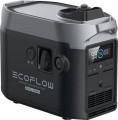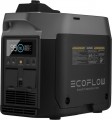Fuel
The type of fuel that the generator's engine runs on.
—
Gasoline. One of the main types of fuel for internal combustion engines. Gasoline generators are usually cheaper than diesel generators, all other things being equal, but they are more expensive to run due to the higher price of gasoline; in addition, they usually have a shorter resource than diesel ones. Therefore, it is believed that gasoline generators are well suited primarily as a backup power source in case of a power outage.
—
Diesel. Diesel generators are usually more expensive than their gasoline counterparts; on the other hand, diesel fuel is cheaper than gasoline, so the increased cost may well pay off with regular use. In addition, diesel generators have a longer resource and a larger power range than gasoline ones. This allows them to be used as both backup and main power sources, including at rather "energy-intensive" objects.
—
Gas. The advantages of gas-fired generators are relatively low noise levels and low emissions. On the other hand, the use of gas as a fuel is associated with certain difficulties: it is necessary to connect to a gas pipeline or regularly replace special cylinders, the fuel system is especially sensitive to leaks, etc. Therefore, there are relatively few such models produced, and most of them are stationary high power generators, in which the mentioned disa
...dvantages are covered by the advantages.
- Gasoline / gas. Models capable of using both types of fuel indicated. This gives the user the opportunity to choose the option that best suits a particular situation, and also reduces the likelihood of being left without fuel at the most inopportune moment; on the other hand, such models are more expensive than single-fuel ones. The technical features of gasoline and gas are described in detail above.Motor type
Model name of the engine installed in the generator. Knowing this name, you can, if necessary, find detailed data on the engine and clarify how it meets your requirements. In addition, model data may be needed for some specific tasks, including maintenance and repair.
Note that modern generators are often equipped with
branded engines from famous manufacturers: Honda, John Deere, Mitsubishi, Volvo, etc. Such engines are more expensive than similar units from little-known brands, but this is offset by higher quality and/or solid warranty conditions , and in many cases, the ease of finding spare parts and additional documentation (such as manuals for special maintenance and minor repairs).
Sound level (7 m)
Sound pressure level in decibels at a distance of 7 m between the noise source and the ear of the equipment operator. Since people do not work in the immediate vicinity of the generator, the parameter will be useful for estimating the noise level at a distance. For example, current European Union regulations require that the sound power of generating sets with a power of more than 2 kW does not exceed 97 dB — at a distance of 7 m, the noise from the generator engine will correspond to a sound pressure of about 72 dB.
Weight
The total weight of the unit - usually excluding fuel; the weight on full tank can be easily determined knowing the tank capacity.
In general, more powerful generators are inevitably heavier, but models with similar characteristics can differ significantly in weight. When assessing these differences and generally choosing an option based on weight, it is worth considering the specifics of the generator's use. So, if the device is often to be moved from place to place - for example, when used "on the road" - it may be worth paying attention to lighter units that are more convenient to transport. However, it is worth considering that the downside of a lightweight design is often an increased cost or a reduced degree of protection. But for stationary use, you can not pay special attention to this parameter - or even the opposite: choose a heavier (and, as a rule, more advanced and functional) option.
Regarding specific figures, it is worth noting that modern generators are generally quite massive. Thus, a small weight for such equipment is considered not only
< 20 kg, but even
20-30 kg ; many units weigh
150-200 kg, or even
more, and the weight of stationary industrial models is measured in tons.

